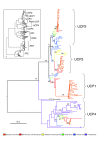Oxidative stress, thermogenesis and evolution of uncoupling proteins
- PMID: 19589183
- PMCID: PMC2737370
- DOI: 10.1186/jbiol155
Oxidative stress, thermogenesis and evolution of uncoupling proteins
Abstract
The uncoupling protein UCP1 provides eutherian mammals with an efficient thermogenic mechanism. Recent work published in BMC Evolutionary Biology, following the identification of UCP1 orthologs in non-eutherians, concludes that this unique function appeared after sequence divergence and purifying selection that allowed functional co-option.
Figures



